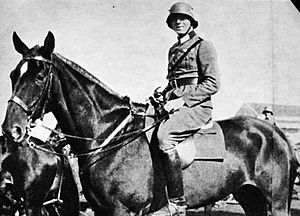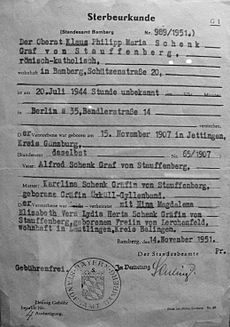Claus Schenk Graf von Stauffenberg facts for kids
Quick facts for kids
Claus Philipp Maria Justinian Schenk Graf von Stauffenberg
|
|
|---|---|

Stauffenberg at the Kavallerieregiment 17 during 1936
|
|
| Born |
Claus Philipp Maria Schenk
15 November 1907 |
| Died | 21 July 1944 (aged 36) |
| Cause of death | Execution by Firing Squad |
| Nationality | German |
| Employer | Wehrmacht Heer |
| Known for | 20 July plot coordinator |
| Home town | Albstadt, Germany |
| Title | Oberst (Colonel) |
| Spouse(s) | Nina Schenk Gräfin von Stauffenberg |
| Parent(s) | Alfred Schenk Graf von Stauffenberg Caroline Schenk Gräfin (von Stauffenberg family) |
| Relatives | Gm Berthold Maria Schenk Graf von Stauffenberg (son), Franz-Ludwig Schenk Graf von Stauffenberg (son) |
Claus Philipp Maria Schenk Graf von Stauffenberg (born November 15, 1907 – died July 21, 1944) was a German army officer. He became famous for being a main leader in the 20 July plot of 1944. This was a secret plan to kill Adolf Hitler and remove the Nazi Party from power.
Stauffenberg, along with others like Henning von Tresckow, was a key figure in the German Resistance movement. This group worked against the Nazi government from inside the German army. Because of his part in this plan, he was executed by a firing squad soon after the attempt failed.
Contents
Early Life and Beliefs
Claus von Stauffenberg and his brothers were part of a German Scout group when they were young. This group was part of a larger youth movement.
He received a good education, like his brothers. He was interested in books and writing. But he chose to join the military as a career.
Stauffenberg agreed with some of the Nazi Party's ideas about national pride. However, he strongly disliked many of their other beliefs. He never joined the Nazi Party. He also remained a practicing Catholic.
He felt conflicted about Hitler. He disliked Hitler's policies but respected his military skills. Stauffenberg was especially upset by the cruel treatment of Jews. He also disliked the way religion was suppressed. These actions went against his strong Catholic beliefs and sense of justice.
The 20 July Plot
From late 1943 until July 1944, Stauffenberg was the main person driving the plan to kill Hitler. He also wanted to take control of Germany. He was determined and good at organizing. His strong actions helped move the plot forward.
Stauffenberg knew that planning to kill Hitler was considered high treason under German law. He even told a young conspirator, "I am committing high treason with all means at my disposal." He believed it was right to protect millions of people from Hitler's harmful actions.

On July 7, 1944, another conspirator, General Helmuth Stieff, said he could not kill Hitler. So, Stauffenberg decided he would personally kill Hitler. He would also lead the takeover in Berlin. By this time, Stauffenberg had doubts about whether the plan would succeed.
But his friend, Henning von Tresckow, convinced him to continue. Tresckow said, "The assassination must be attempted. Even if it fails, we must take action in Berlin." He believed this was the only way to show the world that not all Germans supported Hitler's cruel government.
The Assassination Attempt
Stauffenberg tried several times to meet Hitler, Hermann Göring, and Heinrich Himmler when they were together. Finally, on July 20, 1944, he went ahead with the attempt. This happened at Hitler's headquarters, called Wolfsschanze.
Stauffenberg entered the meeting room with a briefcase. Inside were two small bombs. He left the room to prepare the first bomb. This was hard because he had lost his right hand and had only three fingers on his left.
A guard rushed him to hurry, as the meeting was about to start. Because of this, Stauffenberg could only arm one of the bombs. He left the second bomb with his assistant, Werner von Haeften. Then he went back into the meeting room. He placed the briefcase under the conference table, as close to Hitler as possible. A few minutes later, he excused himself and left the room. After he left, Colonel Heinz Brandt moved the briefcase.
When the bomb exploded, Stauffenberg was sure no one in the room could have survived. Four people died, and most survivors were injured. But Hitler was protected by the heavy, solid-oak table leg. He was only slightly hurt.
Stauffenberg and Haeften quickly left and drove to a nearby airfield. Later, Joseph Goebbels announced on the radio that Hitler had survived. Then Hitler himself spoke on the radio. The conspirators realized their plan had failed. They were found in their offices and captured after a short gunfight. Stauffenberg was wounded in the shoulder.
Execution
Stauffenberg, his assistant Lieutenant Werner von Haeften, General Friedrich Olbricht, and Colonel Albrecht Mertz von Quirnheim were executed. This happened just before 1:00 AM on July 21, 1944. They were shot by a makeshift firing squad in the courtyard of the Bendlerblock building. Truck headlights lit the area.
Stauffenberg was the third person to be executed. Lieutenant von Haeften was next. But when it was Stauffenberg's turn, Lieutenant von Haeften stepped in front of him. He took the bullets meant for Stauffenberg. When his turn came, Stauffenberg spoke his last words. Some say he said, "Long live our sacred Germany!" Others say it was, "Long live the secret Germany!"
The officers were buried with military honors. But the next day, Stauffenberg's body was dug up by the SS. His medals and badges were removed, and his body was burned. Stauffenberg's family had already left the country.
Hitler used the 20 July Plot as an excuse to get rid of anyone he thought might oppose him. The traditional military salute was replaced with the Nazi salute. In the end, over 20,000 Germans were killed or sent to concentration camps.
Family Life
Stauffenberg married Nina Freiin von Lerchenfeld on September 26, 1933. They had five children: Berthold, Heimeran, Franz-Ludwig, Valerie, and Konstanze. Konstanze was born after Stauffenberg's execution.
Berthold, Heimeran, Franz-Ludwig, and Valerie were not told about their father's actions. They were placed in a foster home for the rest of the war. They were also forced to use new last names. This was because "Stauffenberg" was considered a forbidden name by the Nazis.
Images for kids
See also
 In Spanish: Claus von Stauffenberg para niños
In Spanish: Claus von Stauffenberg para niños






